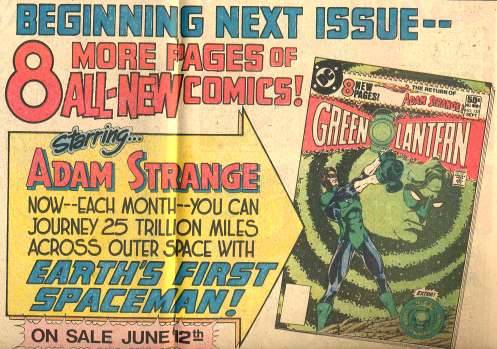#omega men
Green Lantern v2 (Marv Wolfman’s run)
AfterGreen Arrow was evicted from the series,Green Lantern v2 began to get a whole lot better. Green Arrow already had a long residency as a feature in World Finest v1 since 1977 - so don’t feel too sorry for him. Denny O'Neil, who had been writing Green Lantern since it’s DC Explosion revival in 1976 (GreenLantern v2 #90), wrote another six issues after Green Arrow had been booted out of the series and then left DC to work for Marvel comics in 1980. In his last six issues of Green Lantern,O'Neil managed to return Hal Jordan to his roots - Carol Ferris was re-instated as a potential love interest, Thomas Kalmaku (AKA Pieface) was back to being his sidekick, and Hal Jordan was once again a test pilot for Ferris Airlines. Another element O'Neil brought back was Hal Jordan’s arch-nemesis Sinestro - most of O'Neil’s final six issues involved a running plot of Hal Jordan battling Sinestro (with a dash of classic Green Lantern villains Hector Hammond and Star Sapphire thrown in for good measure). Whether it was a good time for O'Neil to cut and run from DC was up for debate as he had previously killed off Batwoman (Kathy Kane) in the pages ofDetective Comics that very same summer.
Green Lantern v2 issues #130 to #132 had guest writers. Bob Rozakis wrote issue #130, Mike W Barr wrote #131 and Paul Kupperberg wrote issue #132. What’s noteworthy about these issues is that we’re starting to see more of Green Lantern’s classical villains appear (Sonar and Evil Star). Another interesting development was occurring: now that Green Lantern wasn’t tethered to Green Arrow, there was more room to explore the Green Lantern mythos, and that included the Green Lantern Corps. The Green Lantern Corps played a prominent role in a few of O'Neil’s post-Green Arrow issues, but more importantly, the Green Lantern Corps received a back-up feature in Green Lantern v2 #130. Written by Bob Toomey and drawn by Alex Saviuk, the Green Lantern Corps stories were some previously completed but unpublished work that finally had a chance to be printed. Fans loved the concept and demanded more Green Lantern Corps stories. [more about that later]
Green Lantern v2 #132 saw a price jump from forty to fifty cents - this involved an extra eight pages of story and this is when Adam Strange became a back-up feature. Written by Jack C Harris and illustrated by Rodin L Rodriguez, the Adam Strange back-ups would run until Green Lantern v2 #147 (but not before switching creative teams to Laurie Sutton as writer and Carmine Infantino as artist). There would be another price increase to 60 cents by issue #144, for an extra 2 pages of story in 1981.
Marv Wolfman became the regular writer for Green Lantern v2 at issue #133. DC comics acquired the talented Mr. Wolfman after he had just left Marvel comics due to a dispute with Marvel’s editor-in-chief, Jim Shooter. Building on the momentum of O'Neil’s ‘back-to-basics’ approach for Hal Jordan, the first thing Wolfman did when he started writing Green Lantern was to shine up all of Hal Jordan’s relationships that had gotten a little vague over the last 20 years. He aimed to bring Hal and Carol Ferris back together, get all the characters set up, give Hal some new friends and create a new support cast as a launching pad for more stories. Wolfman also continued with the hit parade of classic Green Lantern villain appearances: Dr Polaris, Goldface, and Black Hand all appeared during Wolfman’s run. Interesting to note that Wolfman tried to make Goldface THE arch-foe of Hal Jordan. He wanted a foe whose super-powers were less important than the threat of his very existence. Wolfman also brought back an old one-time Green Lantern foe, The Tattooed Man, only to have him killed off*. This was possibly one of the first times a Green Lantern foe had been killed off - fans were a little annoyed by that little stunt. Wolfman explained that the Tattooed Man was killed off because his powers weren’t unique. Wolfman introduces the Omega Men (and the Vegan Star System) in Green Lantern v2 #141 (this would spin-off into it’s own series).
Long-time readers will most likely remember Wolfman as the writer who 'humanized’ Hal Jordan. Wolfman believed that what made a series work were the characters - if they are interesting and if their problems are engrossing. He believed that a blend of good stories, good characters and situations, coupled with interesting action sequences was the key to a successful series. Wolfman and his editors (Jack C Harris,Len Wein,Cary BurkettandDave Manak) decided to infuse a stronger personality in Hal Jordan (more so than done in the past). Wolfman really tried to get to the 'root’ of Hal Jordan. Another interesting plot element that Wolfman likes to explore is the masked crime fighter versus the legal system angle (as seen in Green Lantern v2 #145 - #146) - Wolfman would further explore this idea in his 1983Vigilanteseries.
As you are also probably well aware, Marv Wolfman was the mastermind behind the Crisis On Infinite Earths event - a grand gesture intended to make DC’s continuity way less confusing. You begin to recognize that Wolfman was making a concentrated effort to establish a DC-wide continuity in his Green Lantern v2run:
1. Re-introduction of older characters to a modern audience. These include Space Ranger from Green Lantern v2 #136 - #137, and Bruce Gordon/Eclipso from Green Lantern v2 #136 - #138.Wolfman is a stickler for cohesion, and demonstrating that characters from the old DC anthologies were still an active part of DC continuity is a major part of crafting a sense that everything is tied together and occupying the same universe.
2. Integrating characters from another title into the storyline. The Gordanians make an appearance and the H.I.V.E. are mentioned. Both sets of characters are from the New Teen Titans series that Wolfman was also writing at the same time. Most fans don’t realize this, but Wolfman was writing New Teen Titans,Action ComicsandAdventure Comics while he was writing Green Lantern v2. Integrating characters from another series as a way to create cohesion within the DC universe.
3. Answers the age-old question: if Hal Jordan was facing a global threat, where were all the other heroes? During Green Lantern’s battle with Eclipso, Wolfman made a point to show the rest of the Justice League’s efforts in combating the threat. Trying to keep the idea that although all of these characters occupy different comic book titles, they all occupy the same planet.
4.Wolfman addresses problems about Green Lantern v2 not meshing with prior DC history (case in point: Green Lantern v2 #136-#137 contradicts 1978’s Showcase #100).Wolfman explains that someday soon they will straighten all of that out (pre-lude to Crisis on Infinite Earths?).
5.Wolfman later incorporates some pre-existing Guardians of OA history into Crisis on Infinite Earths. The scene where a rogue Guardian (Krona) tries to view the creation of the universe thus unleashing the anti-monitor already existed prior to Crisis on Infinite Earths being written - Wolfman just retconned it slightly without altering anything major to meet the story’s needs. The Guardians of OA would come to play a major part in post-Crisis DC continuity (see: Millennium event)
The last issue of Wolfman’sGreen Lantern v2 run was issue #151 - after which he plotted issues #152 and #153 (while Gary CohnandDan Mishkin scripted) and became co-editor with Ernie Colon shortly thereafter. Wolfman dropped the series because he was too busy with the Teen Titans,Action Comicsandthe new horror/adventure series that he was planning.Wolfman left the series sending Hal Jordan in a new sci-fi direction (banished from earth by the Guardians of OA), his view was to get Hal off of Earth - Wolfman reasoned that Hal should be the Green Lantern of his entire space sector, not just the planet Earth. Green Lantern v2 #155 was the last issue pencilled by Joe Staton(Keith Pollard took over pencilling chores afterwards) - Staton would return as regular Green Lantern penciller two years later.
What was Wolfman’s impact on Green Lantern during his two year run? Green Lantern’s sales were very good when Wolfman took over, but dipped quite badly after the Space Ranger story arc. Sales of the series started climbing again after the introduction of the Omega Men. Sales for Green Lantern v2 were really high as of issue #147, so Wolfman left the series in pretty good health when Mike W Barr took over as regular writer.
WhileWolfman’s excellent writing, characterization and new direction for the series during this time period is definitely worth noting, I’d say the biggest development during this two year period was the Green Lantern Corps taking a more prominent role in the Green Lantern mythos. The Green Lantern Corps appeared in Green Lantern v2 #127(whileO'Neil was writing) and there seemed to be a pretty good response from the fans, so the Corps started to get a little bit more exposure in the series.
In 1981, a 3 issue mini-series written by Len WeinandMike W Barr was published titled Tales of the Green Lantern Corps that mainly focused on the Corps as a single unit (this included Hal Jordan). Various Green Lantern stories in the past had featured alien Green Lanterns in one-off team-up stories, but suddenly it was made aware that the Green Lantern Corps consisted of a diverse race of aliens with it’s own culture. The critical and sales impact of the Tales of Green Lantern Corps mini-series had a notable impact on Green Lantern v2 - lead stories began to have more alien Green Lantern Corps members and, as a result, more Green Lantern Corps members (Ch'P, Salaak, Arisia, Galius Zed, etc…) were introduced in the pages of Green Lantern v2. The Green Lantern Corps were so popular with the readers that the Adam Strange back-up feature was removed (#148) in favor of more Green Lantern Corps back-up features appearing instead. Paul Kupperberg (who was fresh on his stint from DC’s Ghosts) was writing said back-up tales and Don Newtonand/orCarmine Infantino was illustrating. Incedentaly, Kupperberg/Infantino also worked together on 1982’s New Adventures of Supergirlseries.
*In possibly THE most obscure spin-off ever, the Tattooed Man received his own Vertigo mini-series in 1993: Skin Graft: The Adventures of a Tattooed Man written by Jerry Prosser and illustrated by Warren Pleece.
Post link
Teen Titans Spotlight On…
When one looks back on the 1980s comic book industry as a whole, the more observant reviewer will probably draw parallels between DC’s Teen TitansandMarvel’s X-Men - mainly for the fact that they were both ‘team’ books and hot properties for their respective companies*. Knowing a good thing when they saw it, Marvel created several spin-off 'X-books’ (i.e. X-Factor,Excalibur,New Mutants) throughout the decade. DC also had the same idea and the 80s saw various Teen Titans spin-offs such as 1982’s Tales of the New Teen Titans, 1984’s Baxter edition (set 1 year in the future from the current Tales of the Teen Titans series), and 1986’s Teen Titans Spotlight On…series.
InMarv Wolfman’s own words, the Teen Titan Spotlight On… series was inevitable as Wolfman had different characters he wanted to explore within the Teen Titans universe and he really couldn’t deviate from the story lines of the regular series to focus attention on any individual characters (at the risk of alienating the rest of the team). In my opinion, Wolfman did something brilliant with this series - as opposed to writing all of the issues himself, he had some of DC’s top talent write the issues (while he still retained creative control) - this allowed writers who were not normally affiliated with the Titans to bring a different perspective to the series. You can probably go ahead and call this an 'anthology’ series, due to the creative teams changing with almost every issue. For anyone who may be concerned - yes, George Perez still contributed covers to the series.
I’m kind of feeling this series was overlooked by the fans due to it being a spin-off and all. This is a shame, since if you are a Teen Titans fan/DC continuity hound like myself, this series is absolute gold. As mentioned, there’s lots of attention given to secondary characters who don’t normally get much characterization, so it’s always nice to see something like that. Due to space constraints, I’m basically going to give an overview of the highlights of this twenty-one issue series.
The series debuted with a two-issue Starfire story in which she tries to battle Apartheid (with a little help from a character who looks strikingly familiar to Nelson Mandela) written by Wolfman himself. The story dealt with real-word issues (concerns of social and political relevance injected into the story line) and Wolfman inserted a few subversive political statements, but the main goal was to raise political awareness about the war in South Africa. The first issue was not submitted to the Comics Code Authority for approval (contained crucial story elements that were in violation of code) and therefore does not have a CCA seal on the cover. These issues received a lot of press, as Apartheid and South Africa were all over the media in 1986. This storyline received mixed reviews from readers, but great attention from the media. Starting a new comic book series with a controversial story line was a very intelligent marketing move, Mr. Wolfman.Wolfman later went on to say that he did not wish for Teen Titans Spotlight On… to become “the relevant comic of our time”, and the series pretty much stayed away from topical issues after that.
A few lesser-known Titans get some attention in this series, namely Jericho (Deathstroke’s son), Aqualad, Wonder Girl, Thunder & Lightning, and Frances Kane/Magenta. Frances Kane/Magenta (who many fans compared to Marvel’sPolaris) became a recurring character in Flash v2 several years later. True story: Frances Kane’s superhero name, 'Magenta’, was pretty much invented on the fly by Barbara Randall,Tony IsabellaandWolfman before the issue went to print. Hawk (of Hawk & Dove) got a two-issue solo story written by Mike Baron that takes place sometime between the death of Don Hall (old Dove) and his introduction to Dawn Granger (new Dove). This series was not immune to the Millennium company event and had two cross-over issues: one teaming Aqualad and Aquaman together (written by Dan Miskinand Gary Cohn), and another spotlighting Harbinger written by Barabara Randall (as a direct tie-in to the New GuardiansseriesSteve Englehart was writing). An Omega Men spotlight issue was included (written by Todd Klein and illustrated by Erik Larsen) which took place after the Omega Men series had been cancelled. What’s the Titans connection? Starfire’s brother is a member of the Omega Men and the Omega Men were created by Wolfman. Fans loved the issue (gave them a sense of closure) and hoped it was a prelude to a new Omega Men series (or at least more stories). 'Nay’ to both.
Not sure if many readers remember, but the Doom Patrol were connected to the Teen Titans mythos (the connection being Changeling, who was the ex-patroller named 'Beast Boy’) and this became extremely prevalent in this anthology series. Aqualand battles ex-patroller Mento in a story by John Ostrander (and illustrated by Eric Larsen), the Brotherhood of Evil (who were originally Doom Patrol villains) get an issue to themselves and a Changelling/Robotman team-up (written by Paul Kupperberg and drawn by Dan Jurgens) served as a prelude to Kupperberg’s 1987 Doom Patrol series. Mr 104 (AKA Mr 103) appears for the first time in two decades in the Changeling/Robotman issue, only to be killed off for good later that year. (don’t call it a comeback)
There are three issues that really stand out above all the rest of the great stuff in this series, and I’ll tell you why:
Teen Titans Spotlight On… #13 (1987) was a Cybrog story written by J. Michael Straczynski that pitted him against Two-Face. During the 80s, the Teen Titans typically fought their own gallery of rogues (i.e. Fearsome Five, Deathstroke, H.I.V.E., Trigon’s forces, Blackfire and company, etc) so it was a pretty cool concept to have Cyborg battle a Bat villain. It gave a nice sense of continuity reminding readers the Batman and the Teen Titans all inhabited the same universe, and it was a great story to boot.
Teen Titans Spotlight On… #14 (1987) had Nightwing return to Gotham City to save Batman. This story was written by Micheal Reaves and featured one of Nightwing’s first encounters with Batman post-Crisis in DC. Yes, Nightwing did first appear in Tales of the New Teen Titans #44 (1984), but the 1987 Batman reboot kind of messed up continuity for Batman and affiliated characters, so while I’m not sure if this counts as Nightwing’s first 'official’ encounter with Batman, it seems to be a significant enough story for Nightwing fans to want to collect it. I’m not really 100% how many times Nightwing has met Batman for the first time in the DCU. If any Nightwing historians want to 'school’ me on this matter, I’d be happy to quote you. :)
The last issue of the series, Teen Titans Spotlight On… #21 (1988) was a throwback to the 1960s Teen Titans team (Robin, Aqualad, Wonder Girl and Kid Flash) where they kind of play as a 'mod squad’ to combat organized crime. Written by Mark EvanierandSharman Divono, it wasn’t a retcon, but it was inconsequential enough to be just slid in there and not really have any impact on Teen Titans history. Dan Spiegle illustrated this issue, and if you don’t know who Spiegle is, he’s the artist that illustrated a large variety of Gold Key Comics titles from the 1960s, giving this 1960s Teen Titans story an even more 'authentic’ feel.
Teen Titans Spotlight On… ended suddenly with issue #21. I say 'suddenly’ because there was no real fore-warning that the series was in any sort of trouble in regards to sales. Actually, it was teased in an earlier letter column that Raven would be having her own solo story in issue #22. The reasons given for the sudden cancellation was that Wolfman was too busy with other projects to keep overseeing this series, and the reason he was so busy was because other great Teen Titans projects were in the works (a new Titans team book, a Teen Titans graphic novel called ’Titans of Myth’ by WolfmanandPerez, and a Nightwing solo series). I seem to recall reading something about Perez stating that he no longer wanted to draw monthly issues of anything anymore, and that he would rather only draw Graphic Novels. None of these projects saw completion within the alloted time schedule, btw.
Other than the few negative comments about the Starfire/Apartheid story, fan reaction to this series was incredibly positive. Fans loved the concept and the line-up of writers and artists. There were many requests for Nightwing stories as well as Bat-girl (old Titans West character) stories. Oddly enough, this series generated a lot of hype for a Titans West series that never materialized. I’m thinking it had something to do with Hawk’s two-parter, which gave false hopes to fans that a Titans West revival was in the works.**
Doug Moench wrote a Wonder Girl story that fans felt was a real missed opportunity to explain the whole post-Crisis Wonder Girl/Donna Troy origin which Wolfman had been promising readers for the past 2 years. Could you really blame Moench for not wanting to jump on that grenade? I’m assuming Wonder Girl/Donna Troy’s elusive post-Crisis Wonder Woman connection was going to be revealed in the ’Titans of Myth’ graphic novel WolfmanandPerez were working on.
*In 1982, the New Teen Titans and the Uncanny X-Men even had an inter-company cross-over.
**It was, but never saw the light of day. Read the full story at http://www.titanstower.com/titans-west-that-wasnt/
Post link
Comic books! They’re great. Movies based on them are popular! They’re fun to read, and fun to talk about! But how do you do that?
First, start by double majoring in English and Visual Art.
I’m kidding, but knowing how to talk about literature and art semi-intelligently is your first step. Know what stuff like color theory, lighting, negative space, narrative coherence and character development is, and how to recognize good examples of that, basic stuff. You might even want to learn some theatre terms like the fourth wall, since that might get broken, and you’ll want to know how to talk about it!
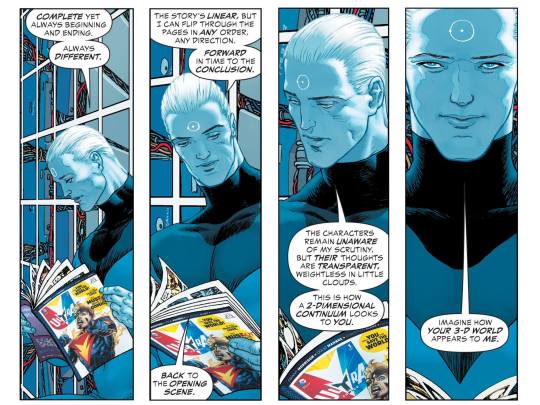
Captain Atom breaks the fourth wall in Pax Americana #1 (with bonus fourth wall breaking from Ultra Comics #1 too). Grant Morrison and Frank Quitely
Next, learn some comic terms!
Art and writing are easy, but what about stuff specific to comics? Floppies are the individual magazines that springs to mind most immediately when you hear the term “comic book,” also called issues. Trade paperbacks are softcover books collecting multiple issues, usually comprising a complete story arc in ongoing comics. Ongoing comics are serialized comics with no set endpoint. These are usually superhero comics like Superman, which run basically forever and tell a multitude of stories by many different writers and artists, or but can also include a long-running series of an original property by a single writer/artist team, like The Walking Dead. Limited series or miniseries are serialized comics, but usually only for a few issues to tell a single story. And perhaps most importantly, what’s the difference between a comic book and a graphic novel? In “””””technical””””” terms, a graphic novel is a comic book publishing a complete, non-serialized story all in one go. So, Watchmen is not a graphic novel, since it was serialized initially, while The Killing Joke is. However, it’s best to avoid the term graphic novel altogether since comic book describes what you’re talking about just as well and doesn’t make you sound pretentious.
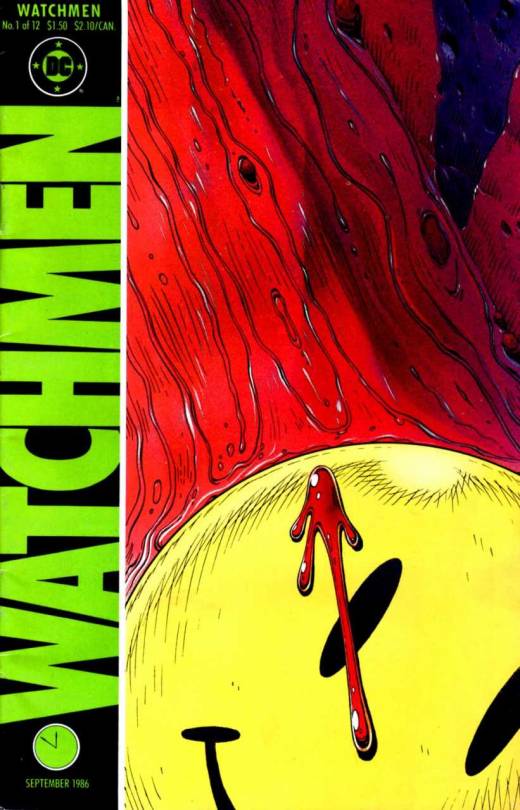
Watchmen #1. Despite commonly being referred to as a graphic novel, it is not, due to being published as individual serialized issues originally. It also heavily relies on the serialized issue format for a large portion of its storytelling, making its designation as a graphic novel problematic, to say the least. Alan Moore, David Gibbons, and John Higgins.

Wonder Woman: Earth One, a true graphic novel. Grant Morrison and Yanick Paquette.
We’ll come back to that strikethrough in a bit, but first let’s go over some terms for the insides of comics. Panels are the boxes on the page, the gutters are the white space in between.
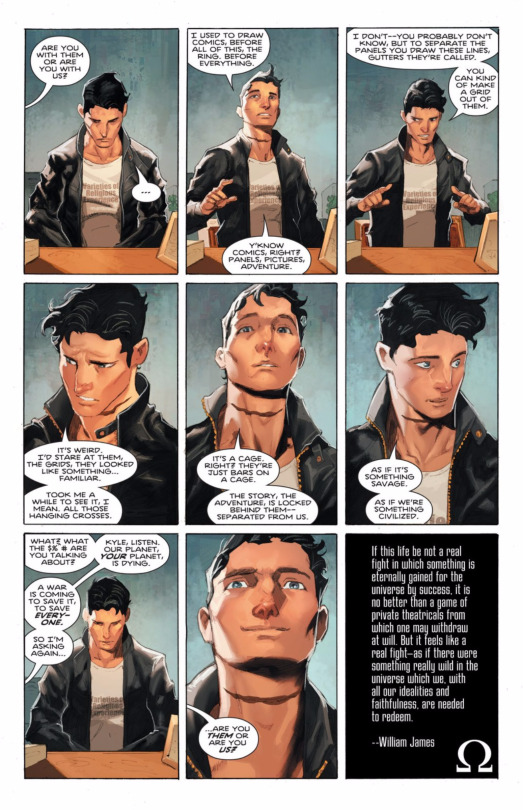
Kyle Rayner explains and points out panels and gutters in Omega Men #12, while leaning on the fourth wall. Tom King and Barnaby Bagenda
Panel-ING is how the panels on the page are laid out, basically the narrative structure of a page. Splash pages are the big, single panel pages showing one cool moment.
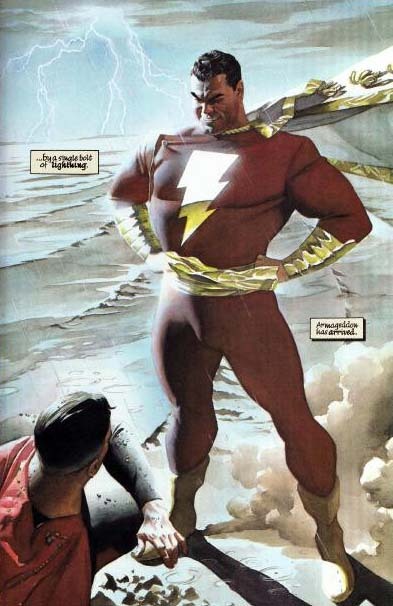
Splash page from Kingdom Come #3. Mark Waid and Alex Ross
Coloring is how the page is colored (which yes, is important to the comic!), and the colorIST is the guy who does the coloring (and no, it’s not as easy as it sounds). We’ll take a slight detour here to explain all the different art jobs. The penciller is essentially the “main” artist, whose art is the baseline of the comic, generally following from the writer’s (self-explanatory) script. The inker then takes the penciller’s work, and adds the blacks in ink. This creates the illusion of depth and lighting. Then the colorist (see above) takes it and adds their colors, which in turn adds more depth and reinforces and adds to the illusion of lighting. There may occasionally be a layout guy, who does a rough sketch of how the panels and basic actions will be laid out on a page. If layouts are done, they’re usually by the writer to give the penciller a rough idea of what they want, but very rarely there will be a separate person doing layouts. These art guys can be three guys (one for each job), two guys (penciller does their own inking), or one guy (penciller does everything). Finally, this finished product gets passed on to the letterer, who takes the dialogue from the script and adds it in the lovely speech bubbles and text boxes we’re used to.
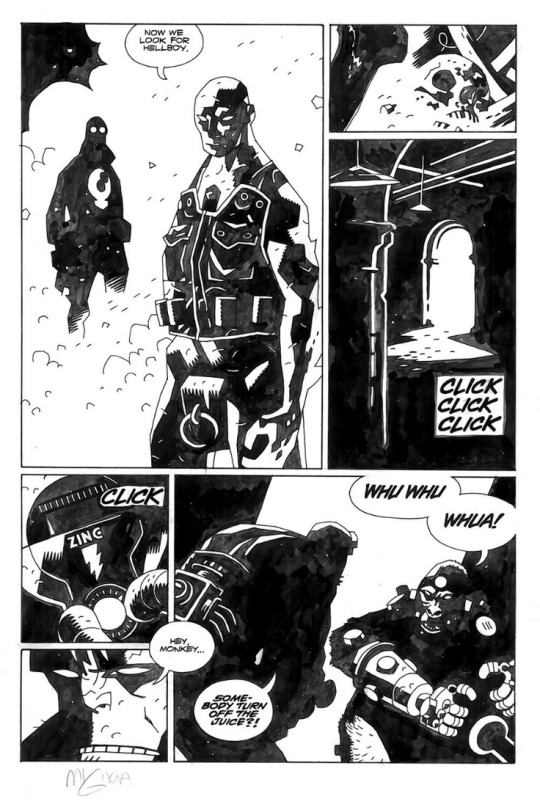
An inked but uncolored page from Hellboy: Conqueror Worm #2, Mike Mignola.

A color process by Moebius
Now that we’ve covered the bits and bobs of the jargon of comics, let’s return to that strikethrough from what feels like ages ago but was probably only a couple minutes. As a reminder, it was about not sounding pretentious. This paragraph might end up filled with a lot of “don’ts,” which I’d hoped to avoid, but hopefully we can make it through together without too much trouble and mental anguish. As I said earlier, avoid the term graphic novel. It does have a real meaning, but in practice it’s essentially used by adults to avoid having to say they read comic books. Consider: do we try to mask our enjoyment of any other medium by using terms of another medium? Do we call music albums listening novels? Or paintings still movies? All this to say, DON’T BE ASHAMED TO SAY YOU READ COMIC BOOKS! Other adults won’t care, and those that do aren’t worth your time. Beyond that, “pretentious” can be a little more vague. Basically don’t be a snob about genre either way, and ESPECIALLY don’t be a snob about companies. Superhero comics can be great! So can indies! So can all-ages! DC and Marvel both have quality works to offer, as does Image, Dark Horse, Fantagraphics, BOOM!, Dynamite, Humanoids and even Avatar! Of course, which works are quality is a matter for the very conversations I hope you use this post to have, we’re not here to make value judgments.
Now, for quite possibly the most important part of being able to talk about comics like you know a thing or two about a thing or two: ACTUALLY READ COMICS
Shocking, I know, but as with any interest, if you want to talk about them in any sort of high-level critical discourse (or just a casual discussion, whatever makes you happy), you need to actually consume a fair bit of it. Wikipedia and movies ain’t gonna cut it here. But what do you read? Comics seem so hard to get into, after all. Well never fear! No one is expecting you to read all 900+ issues of Action Comics in order to know a thing or two about a thing or two. Just read a wide variety of writers, find some you like, and become familiar with their work. Odds are good that you’ll find something to talk about with somebody. I won’t recommend any particular works in this post, since I like letting people form their own opinions and learn on their own, but here are some writers and artists with whom you generally can’t go wrong, and I won’t even say what’s good about them. Almost every creator has their off days, however, so don’t write off a creator if you stumble upon one of their more lackluster works. Anyway, the creators:
Moebius
Grant Morrison
Alan Moore
Brandon Graham
Neil Gaiman
Frank Miller
Frank Quitely
Jaime and Gilbert Hernandez
Goran Parlov
Héctor Germán Oesterheld
Mike Mignola
Greg Rucka
James Stokoe
Jack Kirby
Alejandro Jodorowsky
Nicola Scott
Denny O’Neil
Evan “Doc” Shaner
Bill Watterson
Cliff Chiang
Robert Crumb
Christopher Priest
Greg Pak
Mike Carey
Kurt Busiek
Tom King
Mark Russell
Steve Lieber
This of course is but a small sampling. If you’re trying to get more into comics, don’t be afraid to ask for recommendations! I sincerely hope this primer helps you in your journey, and I hope you read some great comics!


